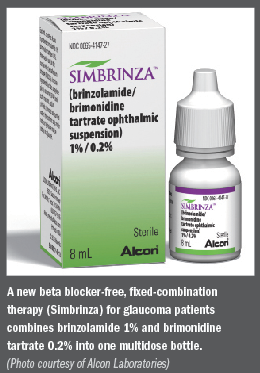Article
Glaucoma medical therapy sees new approvals
New products and medications for surgery became available in 2013, while a heavy eye remained concentrated on the cost of generics.
Take-Home
New products and medications for surgery became available in 2013, while a heavy eye remained concentrated on the cost of generics.

Dr. Fechtner
By Cheryl Guttman Krader; Reviewed by Robert D. Fechtner, MD, Malik Kahook, MD, and Joel S. Schuman, MD
In 2013, glaucoma specialists obtained access to the first beta blocker-free fixed combination IOP-lowering medication [brinzolamide 1% plus brimonidine 0.2% (Simbrinza Suspension, Alcon)], faced growing challenges related to generic medications, and continued to wait for novel agents to make their way out of the investigational drug pipeline and into the clinic.
Ophthalmology Times editorial advisors Robert D. Fechtner, MD, Malik Kahook, MD, and Joel S. Schuman, MD, spoke about these and other issues pertaining to medications for glaucoma care.
Dr. Schuman noted the new fixed combination product enables dual treatment with two IOP-lowering medications of different classes without worry about the systemic side effects associated with beta-blockers.
“Safety of topical beta-blockers is a concern in the glaucoma population because a significant number of older patients are on an oral beta blocker for management of systemic disease,” said Dr. Schuman, Eye and Ear Foundation professor and chairman of ophthalmology, University of Pittsburgh School of Medicine (UPMC), and director, UPMC Eye Center. “A fixed combination therapy that does not compound beta-blocker risk is a nice option for those patients as well as for those with contraindications to a beta blocker.
“Since there is decreased return from topical beta blocker treatment in patients already on an oral beta blocker, these patients may also benefit with greater IOP-lowering efficacy when treated with the new combination versus a fixed combination containing a beta blocker,” he added.

Dr. Kahook agreed that the fixed combination has advantages when combination treatment with an alpha agonist and carbonic anhydrase inhibitor is indicated. Whether or not patients will be able to obtain the product when it is prescribed is another issue, as the new fixed combination is not appearing on the formulary of many insurance plans.
“However, there are signs that this new combination medication is appearing on more formularies, and this is a welcomed change that will benefit my patients,” said Dr. Kahook, The Slater Family Endowed Chair in Ophthalmology and professor of ophthalmology, University of Colorado. “This is a clear example of the effect health care economics has on our ability to best manage patients. When it comes to choosing medications, the insurer’s formulary has a large role in determining what we can use.
“I have noticed that many patients that receive a branded fixed combination prescription from me eventually go on the individual generic components due to pressure from insurance companies or other factors,” he continued. “This will not be possible with Simbrinza since there is currently no generic option for brinzolamide on the market. It will be interesting to see how this plays out over the next few months.”
Dr. Fechtner-professor, Institute of Ophthalmology and Visual Science, and director, Glaucoma Division, Rutgers-New Jersey Medical School, Newark-also commented on the issue of formulary restrictions.
“There is tremendous coercion of patients based on cost, and it is wearing my colleagues down that their educated choices on medications for patients are taking a backseat to formulary decisions,” he said
Development of novel glaucoma medications continued in 2013 without major news, however, there was growing industry interest in injectable glaucoma medications.
Dr. Kahook noted that clinical trials are now beginning with intraocular extended-release products that would eliminate the need for daily topical drops.

Dr. Schuman
Eye on generics
With a generic version of travoprost becoming available in 2013, the number of glaucoma patients using a generic medication for IOP-lowering is growing. Dr. Kahook said that the overwhelming majority of patients are well managed on a generic version of the brand medications. However, ophthalmologists should remain aware that there is a small subset of individuals who do not appear to do as well after being switched from the brand name to a generic.
“We need to keep this possibility on our radar and watch out for patients in whom a generic is not a good substitute,” Dr. Kahook said.
Both Dr. Schuman and Dr. Fechtner pointed out that generic does not always equate to low cost, as the price of some generic medications has risen dramatically in 2013.
“There is tremendous pressure being brought to bear to switch patients to generics, but in our marketplace we have seen substantial increases in the prices of many generics,” Dr. Fechtner said.
“A high price for generic versions of even some older medications is making it difficult for patients and frustrating for physicians,” Dr. Schuman said. “In some instances, generic medications that previously were available at just $4 to $5 for a month’s supply may now cost upwards of 10 times that amount. The same legislators who are determining the payments physicians get from health care need to be directing their attention to the rising cost of medications.”

Dr. Kahook
Medication for surgery
An FDA-approved formulation of mitomycin-C for use in glaucoma surgery (Mitosol, Mobius Therapeutics) became available during 2013. The mitomycin-C kit can be stored in the operating room with a long shelf-life and reconstituted when needed.
Dr. Fechtner noted this is a convenient option that eliminates storage and transportation concerns associated with obtaining mitomycin-C from the in-house or compounding pharmacy, but it is more expensive. The manufacturer, however, was proactive and pursued and obtained a reimbursement code for the product so the institution should be able to recover this cost, Dr. Fechtner said.
Dr. Kahook noted adoption of the new mitomycin-C has been poor because it is so much more expensive than the compounded mitomycin-C that has been widely used for many years by glaucoma surgeons.
“While one might think that we would see a lot of glaucoma specialists gravitate to use of this first ever FDA-approved antifibrotic agent, in my opinion, adoption has been poor due to cost,” Dr. Kahook explained. “Our center still uses compounded mitomycin-C and our costs are a fraction of Mitosol.
“Mitosol might find a role in outpatient centers that find it difficult to obtain compounded products,” he continued. “The status of the reimbursement code over the next 2 years will be a driving factor for adoption and persistence of this new product.”
Joel S. Schuman, MD
Dr. Schuman receives royalties for intellectual property licensed by Massachusetts Institute of Technology and Massachusetts Eye and Ear Infirmary to Zeiss.
Malik Kahook, MD
Dr. Kahook is a consultant to Alcon, Allergan, ClarVista Medical, Aerie Pharma and the FDA. He has intellectual property interests with AMO, Glaukos, New World Medical, Oasis, ClarVista Medical, and Prospex Medical.
Robert D. Fechtner, MD
Dr. Fechtner is a consultant to Alcon and Zeiss.
Subscribe to Ophthalmology Times to receive the latest clinical news and updates for ophthalmologists.
Newsletter
Don’t miss out—get Ophthalmology Times updates on the latest clinical advancements and expert interviews, straight to your inbox.




